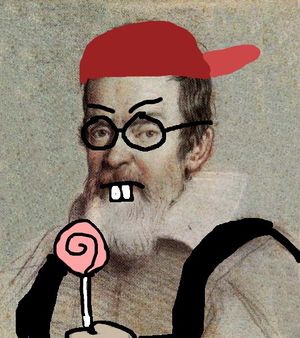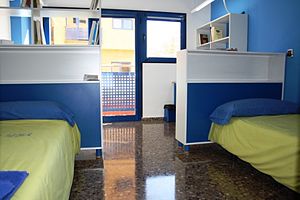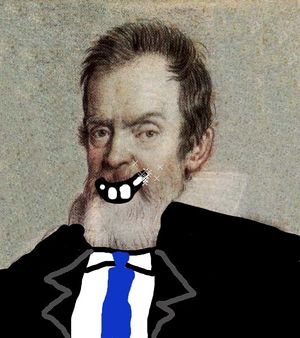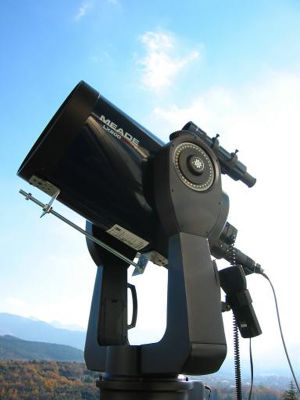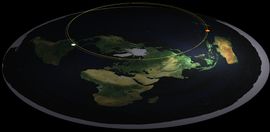Uncyclopedia:Foreign Office/-Italiano
Galileo Galilei - translation for the Dutch Uncyclopedia[edit source]
Templates used[edit source]
- Template:Cit2: a kind of quote
- Template:Cn (Italian version): citation needed
Images used[edit source]
- File:Sistema solare.jpg: solar system
- File:Galileo1.jpg
- File:Galileo2.jpg
- File:Galileo3.jpg
- File:Luiz Inácio Galilei.jpg
- File:Telescopio lx200 10.jpg
- File:Flat earth.jpg
- File:Teoria manga.jpg
- File:Conservapedisti.jpg
- File:Galileos tomb.jpg
Galileo Galilei[edit source]
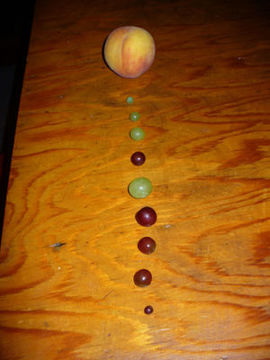
Galileo Galilei was a physicist, a philosopher, an astronomer, a mathematician, a scientist, a comedian, a mime, a plumber, a postman, in short he was a very busy person. But most of all, he was a very big liar [more vulgar word], at least according to the Church of that time. And the modern one too.
Biography[edit source]
The first years[edit source]
He was born in Pisa in 1564 from his father and his mother, quite incredibly. The father, Ermengardo Galilei, a man with a lot of fantasy for the names, was too in his way famous, beacuse he discovered that by peeing on the lime, mortar can be obtained. We know less of the mother, Lovigina Bottazzi in Galilei, only that she was seduced and got pregnant from that adventurer of Ermengardo.
[Both Ermengardo and Lovigina are ridicolous names in italian]
In 1574 the Galilei family Galilei moved from Pisa to Florence, a very unpleasant situation for Galileo, a hooligan of Pisa [Pisa and Florence were rivals, and I think there is still something between the two cities], that at that time was in the first league and was fighting for the Champions League.
There Galileo studied in the convent of Our Lady of the Lames, were he stayed until the age of 15.
In 1581 Ermengardo, fearing that the son would become a penniless bricklayer, inscribed him to the faculty of Medicine, to let him become a doctor and earn a lot of money from the national health insurance. But Galileo, who wasn't able to distinguish a spleen from an Adam's apple, wasn't very attracted by the idea to become a doctor. He regularly didn't go to the lectures, studied unwillingless and gave only 3 exams in a year, risking the recruitment. At the end, after he burped in face of the anatomical pathology professor during an exam, he succeded in being expelled from the faculty, so he could finally study more congenial topics to him, like mechanics, hydraulics, statistic and pussy.
The years of teaching[edit source]
In 1587 the big change: Galileo knew Guidobaldo Del Monte (yes, the famous Man from Del Monte), that even in this occasion said yes. Galileo, even without a degree, obtained then the chair at the university of Pisa, with a monstrous recommendation, I'd say obscene, so much that he often found his Opel Tigra dirtied with inscriptions like: "Galilei, fucking recommended!" His desk [in italian the word "desk" (in schools) and "chair" (in universities) are translated with the same word] had 4 legs and even two drawers, but no covering for the legs, so the students went on looking under his skirt during the lectures.
It was in that period that Galilei expressed some of his most brilliant intuitions, destined to change his story, and this of the whole humanity.
Galilei discovered:
- that a ball on a slope rolls downwards, and not upwards, like many people thought at that time;
- that if you kame an object oscillate, it oscillates;
- that if you let a glass fall, it breaks;
- that a solid body is better than a liquid one;
- that making a wooden sphere and a lead sphere fall from the Tower of Pisa, you can center some people down and risk to be kicked in the ass;
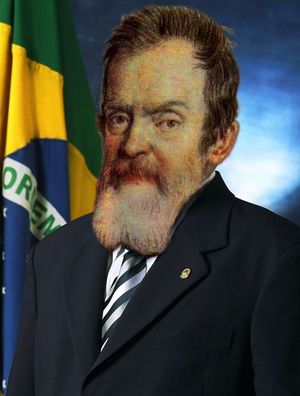
Since at the university of Pisa he was starving because of a small salary, Galileo asked for a new recommendation to the Man from Del Monte that, thanks to the support of some cardinals too, managed to have him called at the university of Padova as a mathematics professor, with a salary of 180 florins, year-end bonus, 30 days of paied holidays and a parking in the hall of the university. Even in Padova his incomparable genius gave some of his best fruits. It's in 1593 that he invented the machine to put back olives' stones, usefull when too many were stoned to prepare the rice's salad. Galileo discovered too:
- that animals fart like us;
- that a body immersed in a liquid becomes a push from the bottom, only if there is someone that pushes, otherwise it sinks (Archimedes' principle 2 - the revenge);
- that a thermometer put under a armpit can measure the fever;
- that it is possible to compress a gas, but what the hell do you gain?
- that in sommer it's warm;
- that in winter it's cold;
- that in spring and autumn it's so so;
- that if you heat a bowl of water it becomes undrinkable, and if you risk and drink it, you'll burn your tongue;
and when a colleague, heating a bowl like the one of Galileo, postulated the laws of phase transition, Galileo said: "Fuck off! I was arriving there too!"
But the importance of Galilei, in these years, went over the simple academic lectures: it's actually with private lectures that his way of thinking spread and became even stronger, thanks to the important students that followed these lectures: Vincenzo Gonzaga, duke of Mantova, [absurd list of people that are surely not known in Holland, replace it with some other people].
Around the year 1597, Galileo worked in the study and realization of measure instruments, like the compasses. He invented too:
- the goniometer
- the set square
- the ruler
- the sticky tape
- the vaporizer
- the veryusefull numerical system with base 12,43
The telescope and the study of the stars[edit source]
Around the half of 1609 Galileo invented the telescope. In fact, the tuscan scientist was looking for something that could help him see the hooter of the front balcony while she was bathing. Deep studies took to the realisation of optical lenses made with high precision, and to the end of the privacy of his unlucky neighbour. Between a dirty thing [I don't know a better word] and another, one day Galileo thought strangely to point his instrument no more horizontally, but to the sky, to see something that doesn't have a pussy between her legs. That's how the illustrious scientist discovered, in addition to female bodies, the celestial bodies: surely less exciting, but not for that less important. Galileo began observations to determine the position of the Sun, the Moon and to remember where he parked the car. The astronomical discovery, realized with the new instrument, that where used to confirm the correctness of the copernical model, were then collected in the Sidereus Nuncius, published in March 1610 with the title Undressing Miranda, to better break the book market.
Now we must understand that the cosmological models used at that time were a lot. In the most acute theories there were:
- The Ptolemaic model: The Earth is in the middle of the Universe, the Sun and the other planets orbit around, there are no other galaxies, aliens don't exist, there are only humans, let's care about ourselves, we'll live 100 years [I don't think there is a better translation fot that in english, proverbs are always hard]. This model was very appreciated by the Roman Catholic Apostolic Church, especially for the last part.
- The bidimensional model, designed in 1486 from the scientist Massimo Sconforto [it means maximum discomfort, maybe can be translated in another way]: the Earth is a flat table and ends at the third kilometer of the Via Aemilia at the junction with the toll of Melegnano. If you go farther you'll fall. If you fall, you'll never save. [hard to transalte, in italian there is a rhyme] A very appreciated model by the Church because it seems that there is a passage in the Bible in which Jesus mentions the toll of Melegnano, and then all was consistent with the Holy Scriptures.
- The freewill model: the Earth is in the middle of the Universe and the other planets and the Sun himself rotate around, set in concentrical spheresthat God himself repairs if the mechanism jams, never asking for money, even in holidays. The other stars around the planets were set in the last ring and all around there was a kind of covering that holds the Universe, probably made of fiberglass. All perfect, all immutable and fixed forever and ever. Everything clear, except for the title: where is the freewill? The Church was enthusiastic: finally a model where everything is imposed and gives to the faithfulls the absurd illusion of being able to choose by themselves.
- The possibilist theory: The Earth is in the middle, the Universe is finite, but it was acknowledged the existance of some life on other planets, but only on saturday evening. This model too was tolerated by the Church because in a tiny passage in the Kebab's Gospel, son of Fnac (subsequently lost), Jesus told that there is nothing wrong eating a pizza and going to cinema on saturday evening.
- The Manga theory: Besides the Earth there are other worlds, but if you dare going there, Mazinger will strike you with his beam and tunr you into dust. Mazinger is sent by God, so it's all right. Theory approved by the Church because it seeme that one of the sons of Isaac was named Mazinger.
- The minimalist-integralist Assyrian-Sumer theory: At the beginning there was the primordial soup (the Knorr), probably never created, so eternal. From the soup came the mountains, the sky, the earth. The god of the sky and the god of the earth generate the god of electric current Enel [it's an Italian elecricity wholesaler, you can substutute it with a Dutch one]. That's everything. There are no other planets, no other Earths, Christopher Columbus is a piece of shit, fuck him and the Americas. Even this theory was appreciated by the Church, because in a passage of the stateless Gospel of Alpitour [stateless in Italian is similar to the word apocryphal, the effect was lost in the translation; Alpitour is a tour operator], son of Upim, brother of Fnac, uncle of Jesus, said clearly that Columbus was driving him nuts.
In the meanwhile Galileo continued his cosmological discoveries. In the next years he discovered Saturn, Venus, the satellites of Jupiter. And an evening he discovered that someone was stealing his car from his balcony. So, seen his discoveries, Galileo was ready to yell strongly that Copernicus was right. It's a pity that Copernicus himself phoned him some days after and told Galileo to mind his fucking business. Yes, that was an epoch in which you couldn't speak and say democratically what you thought. Luckily this is never happend again in Italy[citation needed]!
The dispute with the Church[edit source]
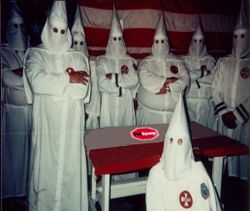
Galileo was really unlucky: the Church liked every cosmological model, even the most badass, except him.
In that very period Galileo finished writing the Dialogue Concerning the Two Chief World Systems, that was published with the title The Countess GianUbalda has a wet hot snatch, again with the objective of better breaking the book market.
The same year Galileo was called to appear in front of the Inquisition Tribunal, together with Luciano Moggi and Fabrizio Corona (two well known Italian criminals, the first for corruption, the second for blackmail) and was charged to be a liar [much more vulgar than that].
Galileo, remembering the end of poor Giordano Bruno, roasted and cooked, decided to surrender without conditions; the inquisitors, amazed of this unexpected submissiveness, raised the ante. During the 3 successive hours poor Galileo was forced to:
- Smell his own farts
- Bark like a dog
- Spit in his own face
- Sing the Forza Italia party hymn in Italian and Latin
- Rub his ass on a grater
- Piss on his manuscript
When the Inquisition was satisfied, Galileo was permitted to go home, on condition that he must recite 17 psalms freely chosen every evening, or he would be electrocuted with Mazinger's laser rays. (At that time the Church was so powerful that it could really make you believe what it wanted)
Galileo died on 8 January 1642. His last words were: "Land of shit!"
Galileo today[edit source]
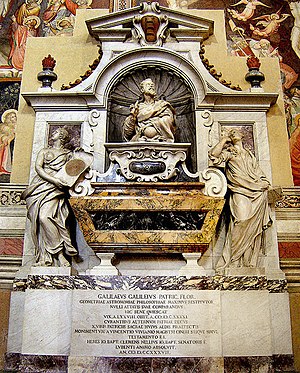
In the following centuries the Church modified its position towards Galileo: the Holy Office allowed the building of a mausoleum in the church of the Holy Cross ["chiesa della Santa Croce" in Italian, if you prefer] in Florence, his books about the motion of the Earth were removed from the Index, so everybody understood the importance of his discoveries. Everybody except one: Benedict XVI, who 2 days after his election as Pope reopened the trial against Galileo, and condamned him adding a life inprisonment to his punishment, absolutely not caring that Galileo was dead for 4 centuries. He moreover added seals to his tomb, and his dust will be removed with a vacuum cleaner to leave the place to his beloved German Sheperd Adolf.
Inventions[edit source]
Besides the study of stars and planets, Galileo is remembered for some important inventions. These are some of them:
- The inclined plane
- The pendulum
- The cutting board
- The flipper
- The citrus-fruit squeezer
